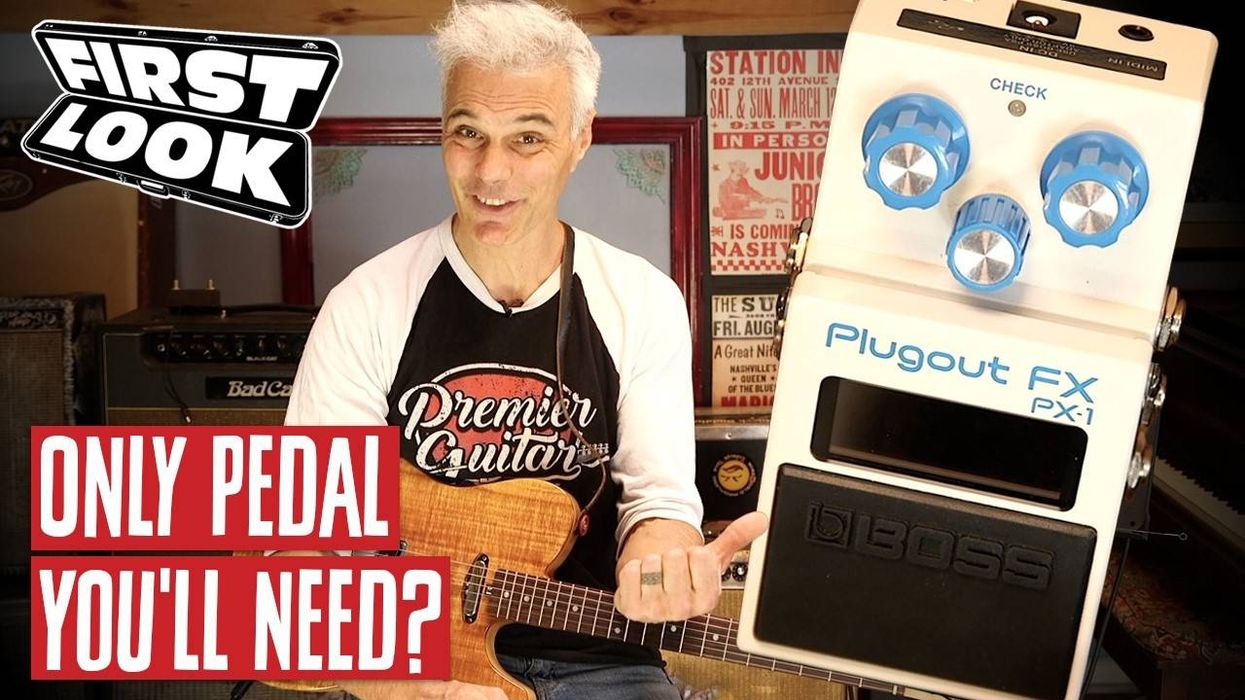In its pretty, transparent white sage finish, the Guild Surfliner couldn’t look more worthy of its name if you stuffed it in the back of a woody and slathered it in coconut oil. Sonically speaking, though, the Surfliner is capable of much more than the garage rock, sunshine-pop, and Chantays covers that the name and silhouette might suggest as a raison d’être. The cool pickup compliment and clever switching scheme make the Indonesia-built Surfliner capable of roughneck rock tones, clarion jangle, dusty lo-fi lead sounds, and honey-sweet blues and soul. Key contemporary design elements prevent it from looking like a strictly retro exercise—if modernity concerns you. And the $450 street price is nice for a high-quality instrument capable of unique tone combinations.
Past Present
Guild’s history is rich with daring solidbody shapes. Some of them, like the S-200 Thunderbird (now called the T-Bird) and S-50 Jetstar, live on in the modern Guild lineup. The Surfliner shares a certain sense of design adventurism with those early 1960s Guilds as well as some cool inherited family traits. It’s great to see the six-in-line, Fender-meets-Firebird headstock that briefly graced mid-1960s S-50s, for example. And the new DeArmond Aerosonic pickups in the middle and neck position are, visually at least, a little evocative of the pickups in the Guild Brian May Signature from the 1990s.
In quintessential Guild style, some of the design idiosyncrasies range to the quirky. The staggered ferrules for the through-body stringing system look a little modern-minimalist alongside the other mostly mid-century-style elements. And the three switches that make up the pickup switching system, while situated conveniently for fast changes, are in peril’s way if you’re a vigorous strummer. It’s not impossible to switch a pickup on accidentally in the course of a downstroke. Also, the switches themselves, which feel more like the type you encounter on modern consumer electronics, don’t look or feel especially well-suited for a guitar as 1960s-inspired as the Surfliner. That gripe aside, it’s hard to complain about the utility of the layout—particularly when you get a feel for the many tone combinations you can produce in a flash. It’s a great idea that could benefit from a little refinement.
The poplar body and maple fretboard-capped two-piece maple neck (a 45-degree angle join is visible between the third and first frets) are well-balanced, and I didn’t experience any neck dive when I played it with a strap. The 10" fretboard radius is a comfortable, super-playable compromise between more curvaceous vintage-Fender and flatter Gibson-style fretboard radii. Paired with narrow jumbo frets, it makes the Surfliner an inviting vehicle for string bending and nuanced finger vibrato. It’s super comfortable for chording, too.
Build quality, by the way, is excellent for a guitar in this price class. Fretwork is carefully executed, the neck is straight as an arrow, and the setup and intonation were pretty much perfect. The white sage, too, which is reminiscent of a vintage blonde-over-ash finish, looks more upscale than the Surfliner’s price, revealing pretty streaks of poplar grain beneath the minty green.
Pickup Pu Platter
It’s nice that the Surfliner is so swell to hold and play, because its base tones—and the variations derived from less common pickup combinations—are a world you can immerse yourself in for a good long while. The LB-1 Little Bucker in the bridge is built around alnico 5 magnets and rated at a modest 5.06k ohm resistance. I like low-output humbuckers and Firebird-style mini humbuckers a lot, and the LB-1 in the Surfliner exhibits attributes of both. High-end output is prominent but chiming and soft in the overtones rather than rabid. Midrange and bottom end output are subdued by comparison. And in certain settings—slow, spacious, and jazzy chord phrasings, for one—the composite voice can sound like sweet bell tones ringing over a relatively boxy bottom and midrange. In most other contexts the LB-1 output sounds more balanced, with a sort of concise but punchy quality that excels for snappy rhythm jabs and spanky garage- and jangle-rock settings. It pairs well with overdrive, too, and the right one (I used a Klon clone) can balance out some of the perceived disparity in liveliness between the low, mid, and high-end output.
The middle position and neck Aerosonic single-coils are both louder and hotter than a Stratocaster’s middle and neck position pickups (a cross between a Strat pickup and a neck P-90 isn’t worlds away). But there are similarities in voice between the Aerosonics and Stratocaster units. The middle Aerosonic has a soft-around-the-edges balanced voice. And the neck unit exhibits plenty of the deep, vocal resonance that can make a Hendrix blues ballad sound so sexy. Combining neck-and-middle and middle/treble pickups yields hum-free and slightly more forceful takes on a Strat’s snorkely, out-of-phase sounds. The airy but substantial neck and bridge combo was the sweetest to my ears. And while all three pickups together sound a bit narrower in focus than you might expect, the combination sounds meaty and punchy with a fuzz.
The Verdict
At about 450 bucks, Guild’s Surfliner is in a competitive price class where taking chances on style can be risky. Yet the Surfliner stands out—and not just for its lines. There are beautiful, rowdy, sweet, and quirky sounds aplenty. It plays as smoothly as more expensive guitars. And though it can look a bit like one style mash-up too many at times, it’s downright pretty at many angles. The absence of a vibrato unit—particularly given the Surfliner name—is a minor crime and an opportunity missed. Then again, the guitar always seemed to be in tune. How you feel about the issue will be down to your own priorities. Is there room for fine tuning, refinement, and revision? Sure. But Guild has built a solid body platform that could evolve in any number of fun and compelling ways, and it’s a perfectly great guitar—and an excellent value—in this first iteration.




























